Related Research Articles

Semyon Konstantinovich Timoshenko was a Soviet military commander and Marshal of the Soviet Union.
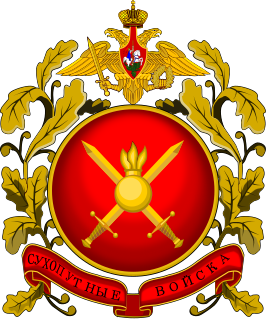
The Russian Ground Forces, also known as the Russian Army, are the land forces of the Russian Armed Forces.
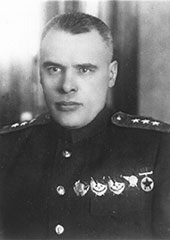
Fyodor Isidorovich Kuznetsov was a Colonel General and military commander in the Soviet Union.
A front is a type of military formation that originated in the Russian Empire, and has been used by the Polish Army, the Red Army, the Soviet Army, and Turkey. It is roughly equivalent to an army group in the military of most other countries. It varies in size but in general contains three to five armies. It should not be confused with the more general usage of military front, describing a geographic area in wartime.
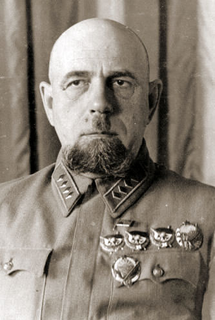
Pavel Efimovich Dybenko, was a Bolshevik revolutionary and a leading Soviet officer and military commander.
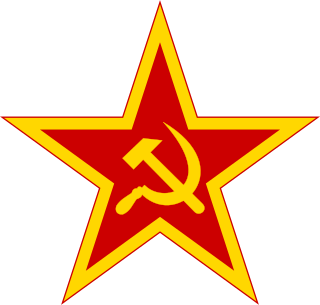
The Armed Forces of the Russian Socialist Federative Soviet Republic, and then the Union of Soviet Socialist Republics, also known as the Red Army and Armed Forces of the Soviet Union, were the armed forces of the Russian SFSR (1917–1922), the Soviet Union (1922–1991), and the Bolshevik Party from their beginnings in the Russian Civil War of 1917–1923 to the collapse of the USSR in 1991. In May 1992, Russian President Boris Yeltsin issued decrees forming the Russian Armed Forces, which subsumed much of the Soviet Armed Forces, while the rest of the former USSR's military, still under unified CIS control, disbanded circa 1992–1993, forming national armed forces instead.

The Internal Troops, full name Internal Troops of the Ministry for Internal Affairs (MVD), alternatively translated as "Interior ", is a paramilitary gendarmerie-like force mostly in succession states of the Soviet Union and in other countries as well, including in Russia, Ukraine, Georgia, Kazakhstan, Kyrgyzstan, Azerbaijan, Belarus, Turkmenistan, Tajikistan and Uzbekistan. It is also maintained as reserve forces in the Armed Forces of Mongolia. Internal Troops are subordinated to the interior ministries of the respective countries.

Dmitry Grigoryevich Pavlov was a Soviet general who commanded the key Soviet Western Front during the initial stage of the German invasion of the Soviet Union in June 1941. After his forces were heavily defeated within the first few days of the campaign, he was relieved of his command, arrested, charged with military incompetence and executed.

The Baltic Military District was a military district of the Soviet armed forces in the Baltic states, formed briefly before the German invasion during the World War II. After end of the war the Kaliningrad Oblast was added to the District's control in 1946, and the territory of Estonia was transferred back to the Baltic Military District from the Leningrad Military District in 1956. The Baltic Military District was disbanded after the fall of the Soviet Union in 1991 and reorganised into the North Western Group of Forces, which ended its existence after withdrawal of all Russian troops from Estonia, Latvia and Lithuania on 1 September 1994.
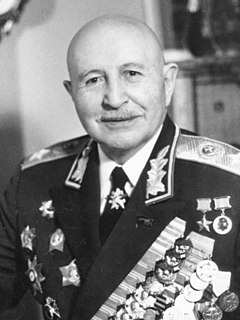
Ivan Khristoforovich Bagramyan, also known as Hovhannes Khachaturi Baghramyan, was a Soviet military commander and Marshal of the Soviet Union of Armenian origin.

The Byelorussian Military District was a military district of the Soviet Armed Forces. Originally formed just before World War I as the Minsk Military District out of the remnants of the Vilno Military District and the Warsaw Military District, it was headed by the Russian General Eugen Alexander Ernst Rausch von Traubenberg.
With the outbreak of the Russian Civil War it was reorganized into the Western Front and in April 1924 it was renamed to the Western Military District. In October 1926 it was redesignated the Belorussian Military District, with its staff in Smolensk. And in July 1940 it was renamed the Western Special Military District. It covered the territory of the Byelorussian SSR and the western part of the RSFSR.
The 8th Army was a field army of the Soviet Red Army during the Second World War.

The 108th Nevelskaya Motor Rifle Division, abbreviated as the "108th MRD," was a unit of the Soviet Ground Forces and the Armed Forces of Uzbekistan. It was the successor to the 360th Rifle Division. The division was created in August 1941 by the State Defense Committee and the Volga Military District Commander, Vasily Gerasimenko, in the Volga Military District. The 360th compiled a distinguished record of service during the Great Patriotic War on the northern sector of the Soviet-German front, including the award of a battle honor and the Order of the Red Banner.

Nikolay Nikolayevich Oleshev was a Soviet Army lieutenant general and Hero of the Soviet Union. Oleshev volunteered for the Red Army in 1918 and served in the Russian Civil War as a clerk at a field hospital. In late 1921 he became a Cheka officer. During the interwar period Oleshev was an officer in the Soviet Border Troops.
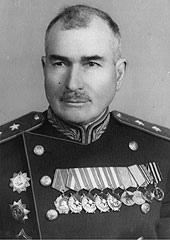
Aleksei Aleksandrovich Grechkin was a Soviet army commander.

The Kharkov Military District was a military district of the Russian Empire, the Russian Soviet Federative Socialist Republic, and the Soviet Union. Throughout its history, the district headquarters was located in the city of Kharkov in northeastern Ukraine.
The 121st Rifle Division was an infantry division of the Red Army during World War II.

Alexander Alexandrovich Luchinsky was an Army General of the Soviet Army and a Hero of the Soviet Union.

Aleksei Ivanovich Baksov was a Soviet Army colonel general and a Hero of the Soviet Union.
The 72nd Mountain Rifle Division was formed as a specialized infantry division of the Red Army in the spring of 1941, based on the 72nd Rifle Division which had previously been the 4th Turkestan Division. At the time of the German invasion on June 22 it was located on the San River west of Lviv as part of the 8th Rifle Corps of 26th Army in the Kiev Special Military District. After having about half of its complement removed to Army reserves or transferred to other divisions it was forced to fall back through western Ukraine under pressure from the German 17th Army until early August when it was encircled as part of 12th Army near Uman. After about five more days of fighting the 72nd Mountain had been effectively destroyed and it was officially disbanded a month later. It was never reformed.
References
- ↑ Минобороны РФ опубликовало уникальные документы о начале ВОВ (in Russian). Infox. 22 June 2017. Retrieved 22 June 2017.
- 1 2 3 4 5 6 7 8 9 10 11 12 13 14 15 16 Так начиналась война (in Russian). Russian Ministry of Defence. Retrieved 22 June 2017.
- 1 2 3 4 5 6 7 "Недооценили угрозу": рассекречены уникальные документы о первых днях войны (in Russian). RIA Novosti. 22 June 2017. Retrieved 22 June 2017.